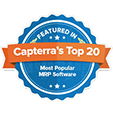
Whether you work in sales and/or marketing, accounting or purchasing, or any of the myriad operational roles in manufacturing or distribution (or perhaps you inhabit the c-suite as an owner or CFO), if your business has more than ONE CONTACT to its name, your success relies on accurate information about your contacts — employees, suppliers and vendors, customers and prospects. Failure to keep your lists “clean” and orderly is not an option.
When I first joined the business world — long, long ago in the “wild West” pre-internet, pre-mobile device days — we relied on pen and paper, notebooks and business cards in a Rolodex. We stopped our cars and jumped out to use any nearby pay phone when a call was necessary.
As soon as Customer Relationship Management (CRM) software became available, I jumped on the bandwagon as a power user, and never looked back. CRM is a time-saver and a lifesaver!
Lesson learned: Simply using customer relationship software alone is not enough. One must master CRM.
... to remove undeliverable addresses and unwanted contacts, whether they’ve chosen not to receive communication from you, i.e., an opt-out, or the contact is inactive or no longer part of your target market. If you’re still in direct mail marketing mode, you'd want to "clean" your physical mailing list. For our purposes here, we’re talking about email lists.
Rule of thumb: In your average contact list, physical addresses may change at the rate of 10-20% per year. Email addresses change at a similar rate — although per month. Of course, rates vary depending upon many variables, such as location, industry, consumer versus business addresses, etc.
Third-party email service providers (ESPs) are smart and getting smarter. What worked just a year ago won’t necessarily work today. Their constantly changing algorithms are better than ever at delivering ONLY what recipients want in their inbox, not to mention the data businesses can use to monitor and track behavior of email subscribers over time, such as open rates, click-through rates (CTR), unsubscribes, engagement and inactivity. A “clean” contact list improves those deliverability outcomes and improves your customers (and prospects) experience with your company.
If you want your emails to get to their destination, i.e., your desired recipient’s inbox — and not filtered out or blocked as spam or junk — then you must continuously monitor and update your data to keep your lists as “clean” as possible. Keeping the most active and engaged contacts in your CRM database is essential to the long-term success of your business.
While nothing guarantees 100% deliverability of your business emails, keeping your contact lists "clean" can make a huge improvement by identifying bad records you should eliminate from your list BEFORE sending.
Not keeping your email lists "clean" leaves your business open to spam traps from leads that signed up using non-deliverable (or fake) email addresses, typos, and more. Email list cleaning helps you avoid these hazards.
Bad lists can slow your email delivery rate to the end recipient, as receivers can suppress your mail or completely block your business domain. Sending emails to a “clean” list of customers and genuinely interested prospects enhances your brand and boosts your return-on-investment (ROI).
Avoiding the dreaded email “blacklist” is one of the best ways to protect your company’s DIGITAL REPUTATION.
Many countries legislate how businesses can use email. In the U.S., that's the CAN-SPAM Act. For our neighbors to the north, it’s Canada’s Anti-Spam Legislation. Wherever you live and however you market to your contacts, know the rules and ensure your business is in compliance. While many email service providers (ESPs) do this for you automatically, here are some of the basics:
First, ensure you consider a robust CRM system in your enterprise resource planning (ERP) selection process, and adequately budget for your ERP purchase.
Maintain your CRM by cleaning contact lists; it's not only a marketing priority; list hygiene is a priority for every person in every business. Performing regular maintenance on your contact lists ensures you have consistent data to analyze and act upon with targeted email campaigns and engagement workflow with your customers and prospects. Think of it as regular housecleaning!
Competition is fierce, so ensure your company has a stellar online reputation.
Contact
xTuple
A CAI Software Company
24 Albion Rd, Suite 230
Lincoln, RI 02865
+1-757-461-3022
About
"xTuple" (verb) — to grow; to increase exponentially. Our mission is to help manufacturing and inventory-centric companies use management software and best practices to grow their business profitably.